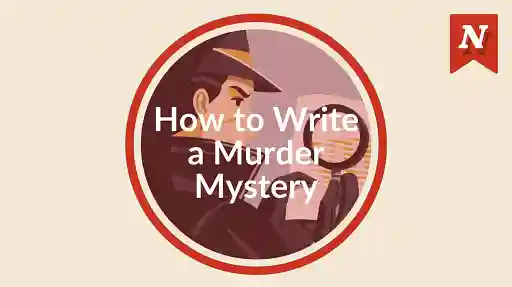Writing a mystery novel, especially one focused on a detective directing a criminal investigation, can be a daunting task when you’re just getting started.
How do you weave the story of a mastermind murderer trying to outsmart a detective without falling into obvious and overdone tropes? How can you balance a cast of characters, each a potential suspect, within a mystery that’s interesting and grounded without being predictable?
If the solution to the mystery at the center of your detective story is too predictable or too nonsensical, the entire book could fall apart. Here are seven tips to write a great detective story and a mystery that only an ace detective can solve.
1. Familiarize yourself with genre conventions
Detective fiction, itself a subgenre of crime and mystery fiction, has subgenres of its own, each with their own tendencies and characteristics which are worth considering when writing.
- In a ‘whodunnit’ or 'whodunit', the reader can become an armchair detective: they attempt to deduce who perpetrated a crime alongside the protagonist, based on clues the author weaves into the story. Agatha Christie’s murder mysteries are all a classic example.
- Police procedurals are stories focusing on realistic and by-the-book law enforcement investigations, like Tana French’s Dublin Murder Squad series.
- A psychological thriller is a mystery with intense character-driven plots and psychological depth (e.g., Gone Girl by Gillian Flynn).
- The subgenre of cozy mysteries is known for lighter, humorous mysteries often set in small communities with amateur sleuths. The Thursday Murder Club by Richard Osman is a good example, for instance.
Each of these subgenres may have some of the following common detective fiction elements:
- Red herrings: Suspects, clues or turns of events the author creates suspicion around that turn out to be distractions from the truth. These keep the suspense high and make detective story resolutions more unpredictable.
- Detective inquiries: The detective protagonist (or duo or team) makes the rounds, inquiring after leads. Inquiries present the opportunity to create further subplots and complications for the primary investigator(s)
- False suspects: Sometimes the police bring in the wrong suspect. This is similar to a red herring, but false suspects are usually more closely related to the crime.
- Surprise plot twists: There are major unexpected story turns that take the reader by surprise
These are just some popular examples, so make sure you know which subgenre you’re working in and read widely within it to understand the genre conventions you’re working (and so that you don’t accidentally set the climax of your psychological thriller at a friendly bake-off in small town England). It’s the best way to understand not only the specific conventions of a, but also of the entire mystery genre as a whole.
2. Create a crime worth solving
Crafting a detective story that hooks your readers involves three key elements: high stakes, well-developed characters, and ongoing intrigue. If one or more of these elements is weak or entirely missing, it’ll be harder to keep readers engaged throughout the investigation.
- High stakes: The central crime should have significant consequences. Even a seemingly minor incident, like a missing pet, can escalate if it uncovers a larger conspiracy, or if it’s of personal meaning to the main character. On the other hand: high-profile crimes, such as a series of mysterious disappearances or ritualistic murders, naturally grab attention. In either case it’s a good idea to connect the crime personally to your detective or main characters to deepen the impact, which ties to the next point.
- Well-developed characters: A mystery thrives on complex characters, both investigators and suspects. Each individual involved should have distinct motives and secrets. Perhaps the widow seeking help isn't as innocent as she appears, or the suspected villain has unexpected reasons for their actions. These nuances make it so anyone could be the culprit, and keep readers engaged.
- Intrigue: Keep your audience guessing by introducing immediate questions: Who? Why? How? These should be on your reader’s mind as early as possible. As the story progresses, provide answers that lead to deeper mysteries.
Agatha Christie's And Then There Were None exemplifies the tree axes of this approach. Ten strangers are invited to a remote island, only to be mysteriously killed one by one. The stakes are life and death, each character harbors dark secrets, and the twists and turns with each new victim keep readers guessing until the very end.
3. Think like a detective
As writers, we’re story detectives! We have to work out how the pieces of each story fit together. Yet not everyone has the skill set of a criminal detective — whether that be forensic capabilities, for example, or Sherlock Holmes’ advanced powers of deduction.
That’s the trick to becoming a crack detective fiction author: become a detective yourself and grow your knowledge of real-life detectives’ skills.
A professional detective, for instance, might deduce information from:
- Physical surroundings: What does the strange arrangement of furniture say about a scene and what could have played out there, for example?
- Psychological observation: If a person behaves a certain way (avoiding eye contact, for example), what does this say about them (that they’re lying?)
- Noticing circumstantial discrepancies: If a suspect routinely went to a specific coffee shop every Saturday morning and didn’t on the weekend the crime was committed, could this be relevant?
- Forensic data: Samples taken from a crime scene tell a story too.
But people don’t start dropping dead around me like flies, you might say — how do I practice investigating anything?
Here, reading is your superpower. To write detective stories that feel real (and stay one step ahead of your readers), prep by reading real detective books, true crime documentaries, or any source of research where actual crimes and investigations are discussed. Learn the fundamentals of forensics and common terminology. Arm yourself with extensive information about how crimes are solved to start thinking — and writing — like a detective.
Depending on the subgenre you’re working within, you can even veer away from realism (to a reasonable extent) and give your detective preternatural abilities of deduction and observation. Just be careful to avoid falling into deus ex machina territory, as you want your protagonist to be relatable still. Speaking of which…
4: Set up a strong cast of suspects
It’s always worth remembering Kurt Vonnegut’s writing advice: Every character in your story should want something. If you’re writing a detective story, this advice is doubly important because all of the characters’ wants will literally be put underneath the magnifying glass: to determine the culprit (or to prove their innocence), your detective will have to probe the motivations of each suspect.
Why do your characters act the way that they do — and how does that affect the way that your plot plays out? A suspect may, for instance, be so desperate to clear their name that they end up acting even more suspicious. Another one might be innocent in the end, but want to pin the blame on someone else due to an old grudge.
As you plan what motive will drive each character’s actions in the course of your story, note down how those motivations logically (or emotionally) led them to do what they do. A credible sense of cause and effect, along with the knowledge that each character’s actions and words have strong motivations, will keep readers on their toes when it comes to catching the culprit.
5: Plant red herrings and use misdirection
Now we've come to perhaps the most famous element in detective stories: the red herring, otherwise known as a clue the author plants to deliberately throw a blinder on the reader. Even the best detectives can follow false lines of reasoning if all the evidence seems to support them.
Let's take Sir Arthur Conan Doyle’s novel The Final Problem as an example, in which the detective Sherlock Holmes in one scene goes out walking with his sidekick Dr. Watson. Watson, however, rushes back back to their hotel when he receives a message saying a woman urgently needs his medical attention. Here's the red herring: the message turns out to be a ploy by the villain, who sends this false information to distract Watson and get Holmes alone so that he can attack him.
Red herrings are one of the most classic elements of detective stories, to the extent that everyone in the world — not just writers! — knows about them. The bad news, of course, is that this makes your job as author even more difficult: readers will often be on active lookout for such red herrings, so you'll have to wield every tool in your kit to make sure your use of red herrings is effective enough to keep the reader guessing.
With that in mind, consider using some of these strategies to paint a herring red:
- Give a probable cause for all the suspects. As an example, the victim could be a person widely despised by the community who’s slighted everyone at some point in the past. If every suspect is glad they’re dead, it warrants considering them as a possible culprit.
- Make a relevant clue point in the wrong direction. Uncertain eyewitness accounts are a great resource for this — someone saw a person leave through the victim’s window at night, but it turns out they were on a secret affair. The open window isn’t the clue, it’s the affair and the jealousy it caused on the actual killer, enough for them to commit the murder.
6. Craft a fitting setting
Picture some of the settings in our most beloved detective stories. There's the fog-drenched London streets of Sherlock Holmes, Christie’s isolated mansions, and even Twin Peaks’ eerie small town nestled in the woods, for instance.
Coming back to Twin Peaks as an example, the winding, twisting roads that cut through the thick forest, and the hazy weather of the pacific northwest, are a mirror of the tension and strangeness of the unfolding murder investigation. The contrast between the town’s idyllic landscapes and its dark undercurrents of corruption, supernatural elements, and hidden secrets, serve to reinforce the story’s themes of duality and deception.
Setting and mood are such important elements of detective stories, in fact, that they’re the defining core of the Film Noir genre of movies. This aesthetic still influences detective stories to this day, in turn. The ever-present darkness, dimly lit offices, and smoky bars create a world where characters constantly navigate deception and danger. The oppressive atmosphere heightens the sense of paranoia and uncertainty, and makes every clue and conversation feel loaded with hidden meanings.
If you make your story’s atmosphere become a complement of your themes and vibes, the setting becomes more than just a backdrop and can serve as a metaphor, or even as a clue. Be deliberate, be specific, and be aware of the senses when you describe your story’s setting.
7. Finish with a satisfying conclusion
The ending should answer every major question. Loose ends leave readers frustrated (or, if purposeful and well-deployed, they leave readers primed for a sequel).
A well-executed reveal makes for a gratifying experience, especially if your story is structured as a classic whodunnit.
The golden rule of writing mystery novels is that the solution should feel surprising but inevitable. If the twist is completely out of left field, readers will feel cheated.
A classic conclusion to a detective story is a speech that reveals everything, either by the main culprit when they’re caught and cornered, or by the investigator as a post-mortem analysis of the case. This part must be carefully executed to make sure you leave no loopholes or unexplained events, all while rewarding readers keen enough to have figured it out; while the ones who didn’t get a satisfying “penny drop” moment instead.
Learn to trust in the reader’s ability to figure things out for themselves. Nailing the puzzling, ‘brain-teaser’ element of your detective story is what the ending is all about, making all but the most astute readers feel like they were very close to the actual answer without giving it away.










Edgar Allan Poe is my absolute favorite detective novel writer ever. Thanks for the brilliant advice, your blog is like a breath of fresh air.
Shon Adams - Over 8 years ago
Hi Shon, thank you! He is an excellent author, indeed. I'm glad you're enjoying the blog.
Bridget At Now Novel - Over 8 years ago
Very good article, and real sound advise. As important as including forensic data in detective mysteries is, it also seems to be the toughest hurdle for an amateur writer. At least it is for me, the technical know-how required to make it read realistic is what baffles me even when I try it in short stories. By the way I've recently written a very short practice story in an attempt to beat the writers' block. I'd appreciate very much if you and your blog readers would give me some feedback on it. If it's okay with you, may I share it here? Many thanks again for this post.
Pradeep - Over 7 years ago
With ebooks and podcast failing, I want to go down to shorter stories, hobby-only, but I do miss the learning that serious `beyond author 101´ includes. Psychology, Criminology, and Folklore (legends for horror fiction) were a lot more fun than watching at a TV screen (like a sedated lunatic).
Andre Michael Pietroschek - Over 3 years ago
Hi Andre, thank you for sharing that. On the contrary, podcasts and eBooks are still very popular formats, it depends on the author/broadcaster of course (but this is where good market research goes a long way, as well as good editors). I don't think TV will replace reading any time soon. Thank you for reading our blog and sharing your thoughts.
Jordan - Over 3 years ago